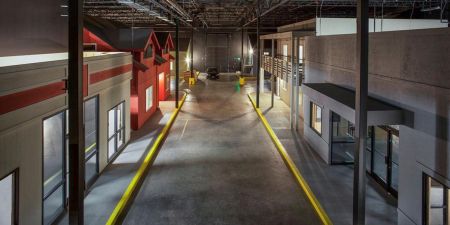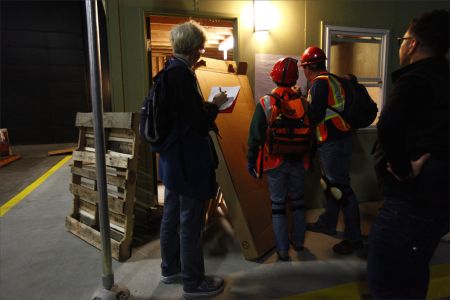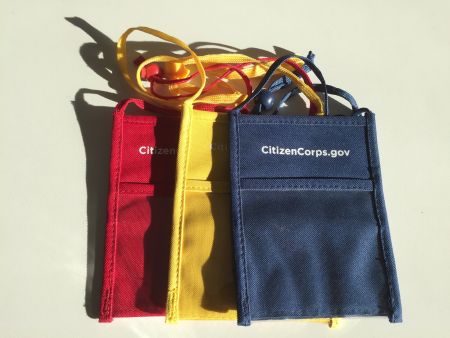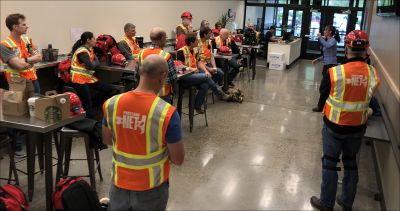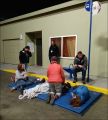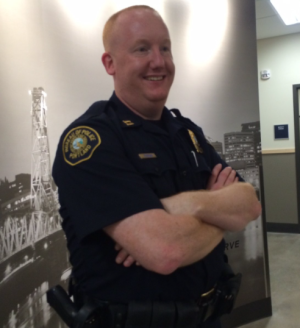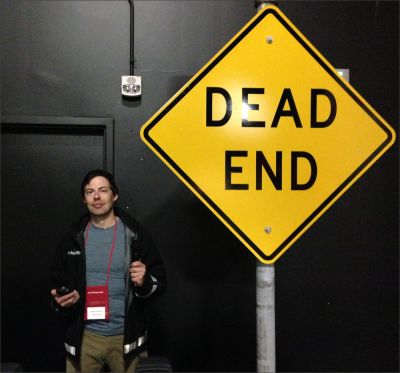Scenario Village
Scenario Village is a 13,400 square foot indoor "mock town" owned and operated by the Portland Police Bureau (PPB), located at 14912 NE Airport Way. The Village layout includes six buildings of various shapes and sizes (commercial and residential), streets, alleyways, and an observation deck. A Scenario Village Exercise is among the highest quality training opportunities available to NET volunteers.
NET volunteers use the Village several times a year for comprehensive response exercises. In a typical exercise, NETs conduct search and rescue, triage, medical treatment, radio communications, SUV management, and leadership/delegation to respond to moulaged Survivors. A single exercise at Scenario Village can include distinct neighborhood teams or members from many neighborhoods blending into a team and working together.
...
...
Scenario Village Exercise Overview
All subheadings in this section describe a typical Scenario Village exercise but much listed here is fluid and can change. The Village is versatile enough that the PBEM exercise organizer could consider any number of alternative training scenarios, or add/take away/change any of the exercise elements described below. The PBEM exercise organizer is responsible for appropriately shaping expectations about the exercise if anything described in this section is going to significantly change.
This applies also for the typical exercise scenario for Scenario Village, which is: NET rescuers are responding in their neighborhood in the aftermath of a megathrust earthquake and mass casualty situation (MCI) on an afternoon with clear weather.
...
Participant Roles and Responsibilities
The term "participant" encompasses many groups of people, not just those playing in the exercise. Groups of participants involved in the exercise, and their respective roles and responsibilities, are as follows:
| Role | Description | Identified with |
|---|---|---|
| Player | Players are search and rescue personnel with an active participation role in the exercise. Players discuss and act in response to the simulated emergency. They bring their own response gear and "practice as they play". | NET or CERT ID badge. |
| Proctor | Proctors work together to plan and manage exercise play, and set up and operate the exercise site. Proctors direct the pace of the exercise, provide key data to Players, and may prompt some Player actions to ensure exercise continuity. In addition, they monitor the exercise timeline and supervise the safety of all exercise participants. Players and Observers must always follow any directions given by Proctors. | Red lanyard and badge holder. |
| Survivor | "Survivors" are actors in the scenario playing as injured (for Players to render aid to) or uninjured (who may provide resources or disrupt the response effort). Injured Survivors often wear moulage to simulate their injuries. Injured Survivors will also wear a blue lanyard with a card that displays patient information such as breathing rate and other injury descriptions, to act as clues for how Players should triage and treat them. The reverse side of the card in the lanyard reveals whether they are Green, Yellow, Red, or Black. | Blue lanyard and badge holder. |
| Observer | Observers are guests to the exercise and Players should not address or communicate with them during the exercise; they are "invisible". Some Observers attend to document the exercise with photo or video; if that happens, Proctors will let participants know so they can opt out of being photographed. | Yellow lanyard and badge holder. |
| Moulage Technician | Moulage techs apply injury simulation makeup to Survivors. Unless they choose to enter the Village as Observers, Players will not see them. | Yellow lanyard and badge holder. |
...
Exercise Location, Rules, and Expectations
Scenario Village takes place at the Portland Police Bureau Training Division facility, 14912 NE Airport Way in Portland. Exercise participants are guests of the Portland Police Bureau. NETs continuing to exercise at Scenario Village depends on following the rules of this highly secure facility. Failure to abide by appropriate conduct can result in a permanent ban from the facility, and removal from the NET program in egregious cases.
You can download a rough map of the Village by clicking HERE.
...
Facility rules
- In all things, follow the NET Code of Conduct.
- THE MAGIC WORDS ARE "REAL WORLD!" If a Player/Survivor/Proctor at any time observes something unsafe, or a situation that is about to become unsafe, they should yell "REAL WORLD". All in earshot will pause while a Proctor assesses the situation and will un-pause the exercise when/if appropriate.
- Leave the space better than how you found it. Please clean up your trash and other disposables.
- Follow any and all instructions given to you by PPB officers and employees. Follow any posted rules at the facility.
- Unless given permission and/or escorted by PPB or PBEM staff, you may not enter any area of the building besides the immediate lobby (including restrooms) and the Village.
- Follow all identification protocols you are instructed to. You will likely be provided with a color-coded Tyvek bracelet to identify you as an exercise participant; do not remove it while in the facility.
- Except inside Scenario Village itself, do not leave any facility doors open behind you. NEVER chock a door or leave an outside door open.
- Do not bring guests without clearing them first through PBEM. If they are not a NET volunteer, they may need to undergo a criminal background check.
- Sign in when you arrive. If the scatterbrained PBEM employee running the exercise forgot to bring a sign-in sheet, make one and turn it in to PBEM.
- Do not bring cutting instruments/sharp instruments into the exercise area (bandage shears are an exception). PPB personnel will confiscate them, to be returned to you before you leave. That's right: no small pocketknives or multitools with pocketknives either.
- A PPB Officer will perform a pat-down of every person entering the exercise space to check for weapons. Like extra screening by TSA at the airport.
- Do not leave any permanent markings on any walls. If you want to make building markings in the Village, use a sheet of paper (provided by PBEM).
- Wear closed toe and sensible footwear. Heels, mandals and sandals are not permitted in the facility.
...
General tips about facility use and expectations
- Make extra planning to arrive on time. Again, this is a secure building. The front door is locked as are all areas of the building; and, nobody staffs the front desk while the exercise commences. If you arrive late, you have to call someone inside (who may not hear their phone because of background noise) and then someone has to be escorted through locked areas to get you and escort you back.
- Exercise the way you would respond. Be ready to put your team's Operations Plan into action if you have one. For equipment, with the exception of sharp/cutting instruments, bring the equipment you would bring in a real deployment. Doing these things will reveal the best and the deficient practices in how you prepare equipment and organize your team.
- The experience of individual Players will vary. For example, a Player who remains at the command post to relay radio traffic will have a significantly different experience from a Player extricating Survivors. PBEM's hope is that individual teams will ultimately have multiple opportunities to participate in these exercises, allowing for Players to try out different roles.
- If you happen to see any moulaged Survivors, avoid looking at them if possible. That's like seeing answers before an exam. Anyway, staring at someone's injuries is just rude.
- You will be frisked and your bags thoroughly checked by a PPB or PBEM employee. So leave the bazooka at home, ok? It gets awkward when you bring that.
- Keep track of which and how much/many disposable supplies you use in the exercise, and report to PBEM by email after the exercise (net@portlandoregon.gov). Disposable supplies include bandages, emergency blankets, masks, caution tape, and so on. PBEM will have replacement supplies shipped to you shortly after the exercise.
...
Exercise Objectives and Core Capabilities
The following exercise objectives in the table below describe the expected outcomes for the exercise. The objectives are linked to core capabilities, which are distinct critical elements necessary to achieve the specific mission area(s).
| Exercise Objectives | Core Capabilities |
|---|---|
| Organize a command post | Leadership/delegation, operations planning, radio communications, organizing/distributing/using documents. |
| Conduct search for survivors | Size-up, marking buildings, search patterns. |
| Triage survivors | Injury triage, limited medical treatment, establishing medical triage area. |
| Survivor recovery | Cribbing, patient packaging, patient transport to treatment area. |
| Team support radio communications | Proper use of FRS/GMRS radios, frequencies, and tactical communication. |
| Report to the ECC | Proper use of the DAMM. |
| Manage SUVs | Disaster psychology, volunteer management. |
...
Exercise Assumptions and Artificialities
In any Scenario Village exercise, assumptions and artificialities ensure completing play in the time allotted and/or account for logistical limitations. Scenario Village participants should accept assumptions and artificialities, and not allow these considerations to negatively impact participation.
- Cell service is "down"; players cannot use cell phones to communicate with each other. However, participants may use the DAMM.
- Because of security rules of the Village, players cannot carry cutting instruments/sharp instruments into the exercise area.
- Survivors will wear triage cards around their necks with information about their condition such as heart rate, etc. Many "survivors" will also wear moulage to simulate injuries.
- Players are NOT permitted to mark up the buildings in the Village (to convey casualties inside, etc). PBEM provides large sticky note pads to write on and place on the outer walls of buildings.
- No patient transports on stairs. Where Players would normally transport a patient down a set of stairs, the actor will stand up and walk slowly with the responding Players. Once they clear the stairs, they may re-commence a patient transport.
...
Variable Exercise Elements
The following exercise factors can be adjusted, added, or removed by exercise proctors to make the exercise more or less challenging.
| Element | Settings |
|---|---|
| Aftershocks | Proctors can whistle for attention and declare an aftershock is taking place. That might change some elements in the exercise such as injury statuses, missing people, or relevant building damage. |
| Background noise | Proctors can set up a sound system in the Village with white noise, or play stressful noises such as loud traffic, explosions, chainsaws, people screaming in distress, political stump speeches, angry goats, the theme music from "Conan the Barbarian", and more. Background noise will also interfere with use of tactical radios. |
| Building damage | Some sides of the buildings may have signs with messages such as "The back of the house has partially collapsed". Players should treat the signs as literal during the exercise. |
| Downed electrical wires | Proctors may set up downed wires that present a hazard and must be avoided/worked around. |
| Fallen debris | Fallen debris in the form of wood blocks might cover a Survivor. |
| Gas meter | A gas meter attached to a building may leak (sound simulated by a SCBA tank). |
| Hazardous Materials NFPA 704 diamond | Participants might see an NFPA 704 diamond-shaped sign warning of hazardous materials in a building. |
| Lighting | Proctors can use the artificial light and the large access doors in the Village to control visibility and simulate time of day, up to and including pitch dark. Individual buildings also have exterior and interior lighting. |
| Persons with Disabilities | One or more Survivors may be using a wheelchair or other assistance device, have a service animal, or have some other condition that bears on how Players choose to respond. |
| Persons who do not speak English | Players may encounter one or more survivors who do not speak English. |
| Smoke machine | To simulate high dust (NOT smoke from a fire, which NET volunteers cannot respond to) proctors may set up a smoke machine to reduce visibility for participants. |
| Strobe | Sometimes a strobe light will be installed in an area to increase the stress and confusion level. |
| Survivors (injured) | Possibly the most important exercise element is the number and condition of injured Survivors. |
| Survivors (uninjured) | Uninjured Survivors may be helpful SUVs, unhelpful SUVs, someone providing information, someone trapped, or someone causing trouble. |
...
Exercise Improvement Suggestions
Over the years, NETs have made suggestions concerning how PBEM might improve the exercise. The collapsed table is a list of things PBEM has not yet tried.
Exercise Timeline
Before you visit the Scenario Village facility, please view the section on how to prepare for the exercise and arrive ready to go.
Unless you receive an email with a different timetable, the timetable for your experience at Scenario Village looks like this:
| AM SHIFT | PM SHIFT | TIME | Personnel | Activities | ||
|---|---|---|---|---|---|---|
| From | To | From | To | |||
| 0800 | 0900 | 1230 | 1330 | 60 min. | All non-Player personnel | Set up Village for play, moulage Survivors, set up refreshments in the lobby. |
| 0815 | 0830 | 1245 | 1300 | 15 min. | Survivors | Optimal window of time for Survivors to arrive to get moulaged. |
| 0830 | 0900 | 1300 | 1330 | 30 min. | Players | Players arrive at PPB Training Division and gather in lobby, discuss operations plan, clarify player roles (led by Incident Team Leader). Doors will not open to Players sooner than this time. |
| 0900 | 0910 | 1330 | 1340 | 10 min. | Players, Proctors, and Observers | All-hands safety briefing; a proctor will go over safety rules and exercise expectations. |
| 0910 | 0930 | 1340 | 1400 | 20 min. | Players, Survivors, PPB personnel | All Players, Survivors, Observers, and Proctors bag checked, marked, and cleared for entry into the Village area. As Survivors process in, Proctors will place them, answer questions, and listen to awesome music. Meanwhile, Players gather in the Village ready room and/or outside doors to the Village and discuss operations planning further. |
| 0930 | 1015 | 1400 | 1445 | 45 min. | All Players and Proctors | First run through for Players. Proctors may allocate more or less time during this period depending on whether the Players struggle with the response effort. |
| 1015 | 1030 | 1445 | 1500 | 15 min. | All Players, Survivors, and Proctors | Hotwash and assessments for the first run through. Proctors usually start with most critical observations, and then the ITL is asked for their opinion. Survivors will sometimes make observations as well. |
| 1030 | 1045 | 1500 | 1515 | 15 min. | All Players, Survivors, and Proctors | Players briefly retire to the staging area to plan the next run. Meanwhile, Proctors reset the Village and re-place the Survivors. |
| 1045 | 1130 | 1515 | 1600 | 45 min. | All Players, Survivors, and Proctors | Second run through for Players. |
| 1130 | 1200 | 1600 | 1630 | 30 min. | All Players, Survivors, and Proctors | Final hotwash and discussion; parting reminders. Players/Survivors/Observers go home, Proctors remain to pack up the Village and clean. Please let the Proctors end the exercise at this time so they can go home when they planned to. If Players or others have questions or observations they would like to add, they should email a NET Coordinator. |
Note that delays can and do happen, and the schedule is adjusted accordingly in those situations.
...
Preparing for Scenario Village as a Player
General Preparation for Scenario Village
- Have one or two key phone numbers handy. If you are late, or get locked out of an area, be ready to call a fellow NET or PBEM staff in the exercise so someone can let you in.
- If you have time, review the suite of NET training refresher videos posted here on the NET Vimeo account: https://vimeo.com/showcase/10725195.
- If inclined and you have time to, skim through the Basic CERT textbook. Give particular attention to scene sizeup, conducting interior search operations, triage, patient carries, ICS document use, treating life threatening conditions (the "three killers"), head to toe assessment, wound care, and fracture treatment.
- Re-familiarize yourself with your FRS/GMRS radio if you plan to use them.
- If you plan to attend Scenario Village with your team, go over your team's Ops Plan and make sure everyone on the team has agreed who will take which roles (particularly Incident Team Leader).
- Check through your response pack. Make sure you have everything you need where you plan to find it, and remove sharp instruments.
...
Preparing Yourself Mentally
- Prepare for some stress. Scenario Village training is intended to be tolerably stressful so that participants can experience, and practice managing, stress induced impairment of the brain functions that are most sensitive to stress: executive function, sensory awareness, attention, and memory.[1] For the exercise to be a meaningful training experience, the exercise designer is going to introduce some level of stress. If you find the exercise easy, the exercise designer did their job poorly. If you find an exercise too stressful, ask your Incident Team Leader or the exercise proctors to turn it down, and/or check out with your Team Leader and take a break on the observation deck.
- The exercise is not a competition between volunteers on a shift. On the contrary, as they would in the real world, PBEM encourages Players to work collaboratively.
- Don't fret about "failure" or "making mistakes". As long as everyone walks away from the exercise uninjured (in the real-world) the only way you can "fail" is by not learning anything. Use the Scenario Village space and time to make mistakes and experiment; that's exactly why we exercise. It is strange the number of volunteers who walk away from Scenario Village feeling unsettled, even dispirited, like they "didn't do a good job". As long as you learn from the exercise, you did a good job. Go get some (locally made) ice cream when it's over, OK? You earned it.
- This is, after all, a police training facility. As such, you will see signs of how police train and use the Village when NETs are not in it. Though PPB never uses the Village for live fire exercises, you might see spent blank cartridges. You may notice signs of forced door breaching. If you expect seeing these things will make you feel uncomfortable, you may want to reconsider participation at Scenario Village. Though a shooting range is on site the sound is very well insulated and participants have never commented on hearing gunshots (the range is rarely used on weekends anyway, which is when NETs are typically there).
...
Scenario Village Photo Slideshow
More Scenario Village photos are posted on the NET Tumblr HERE.
...
Lessons Learned From Scenario Village
The table below represents cumulative observations and recommendations from Scenario Village exercises over the years. This list was first compiled by Eva Love with PBEM, and new observations are added iteratively. Readers can sort the list by VSF as well.
| VSF | Observation | Impact | Recommendation |
|---|---|---|---|
| VSF 05.01: Incident Team Leader | Plan for less standing around.
The ITL sent in several teams for recon and initial assessment while members of the other team stood out in the cold. (Although we did move inside for the second round). It would have been better to find a way to utilize everyone or at least switch up the teams so that the same people weren’t left standing around while the first teams did their work. |
Inefficient use of personnel resources. | ITL could plot out how to shift roles during periods of a response, so everyone has a job to do at a given time. |
| VSF 09.01 Search & Rescue | Consider whether your flashlight is powerful enough for S&R. | A weak light leads to hazards and poor observation/situational awareness. | At some point, PBEM or the NETs should spec out minimum standards for search and rescue flashlights. A cursory internet search suggests 500 to 700 lumens (but, be sure you're not shining it in someone's face when you're rescuing them). |
| VSF 02: Communications | Need to standardize radio communications; specifically, what to say and in what order, as well as how to hold a radio for best transmission. | Confusion over radio comms. | This is something that should certainly be factored into Team Operations Planning. |
| VSF 05.01: Incident Team Leader | NETs referred to the ITL as the "mothership person". | Turn of phrase that helped clarify the role of the ITL as someone who does not leave post but has direct reports. | If a team is suited to it, use the term. |
| VSF 05.01: Incident Team Leader | Some Incident Team Leads do not give clear objectives when they deploy the team. | NETs wander around the Village without a clear idea of what they should be doing, or combining goals that should not be combined (e.g. rendering triage but interrupting the effort with medical treatment). | Incident Team Leads should provide clear objectives to their team, such as "First, do scene sizeup/triage and report back. After you report, we'll begin treating the survivors who need it most. Transport them to a medical treatment area if safe to do so.". |
| VSF 09.01 Search & Rescue | Volunteers often neglect voice triage just before entering a structure. | NETs conducting assessment and triage make themselves work harder, lose time, and increase their risk when they neglect to ask Survivors to come to them. | Strike team leaders should remind the NETs they work with to conduct voice triage before entering a structure. They should say "Hello! We're your neighbors and we're here to help. If you can walk, please walk towards the sound of my voice". Be ready to direct them to a safe gathering area nearby. |
| VSF 08.04: Treatment Area Manager | Survivors are dumped off at the Medical Treatment Area with no information. | Time lost when medical treatment NETs duplicate some of the work Search & Rescue NETs have already completed. | Search & Rescue personnel should provide a brief report or documentation on what they know/don't know concerning the Survivor's condition. |
| VSF 05.01: Incident Team Leader | Different individuals acted as Incident Commander, ARO, and scribe. | Having a distinct Incident Commander, ARO, and scribe improves communication and coordination during an exercise. | There should always be at least one Incident Commander, one ARO, and one scribe. In certain instances, it may be useful to have a scribe for both IC and Ops if they are in different locations. Scribes should also use paper to record current status, incident log, and observations. |
| VSF 15.03.01: SUV Lead | Incident Commanders, medical, and Team Leaders delegated new roles to SUVs as the exercise scenario changed. | Doing so kept all SUVs engaged and active. It also helped ICs, TLs, medical, and SUVs adapt and respond to new scenarios. | Identify roles and assignments at the start of the exercise but be prepared to adapt as needed. IC and Ops should always be anticipating future delegations. SUVs should be ready to change roles at any moment. |
| VSF 08.04: Treatment Area Manager | Medical was situated near the Incident Commander. | Communication improved when medical was located near the Incident Commander. Complex information could be shared face-to-face. Additionally, the IC could better monitor the medical staging area and delegate as needed. | The medical staging area should be located near the IC when possible. |
| VSF 02.06: Tactical Comms | Participants used tactical callsigns when using radio communications. | This prevented confusion and saved time during the exercise. | Encourage NETs to use tactical callsigns during Scenario Village exercises. Standardizing modes of communication will better equip NETs to communicate during actual emergencies. |
| VSF 15.03.01: SUV Lead | SUVs were given new tasks when they finished their assignments. | SUVs successfully adapted to support areas of greatest need as the situation changed. | Continue emphasizing adaptive exercises during Scenario Village. NETs should be able to focus on a specific task as well as quickly change gears. |
| VSF 02.03: Team ARO | Communications prior to and during events can be disorganized. | This makes it difficult to execute the exercise and confuses teams and participants. In certain scenarios, the ARO was overwhelmed by the number of calls being received. | Communications prep should be conducted before the start of the exercise. There should always be at least one Op Control person assigned to handle the radio traffic while another plans and directs. Radio communications should be repeated to ensure all participants receive them. Continue to work on radio discipline. Complex information should be shared face-to-face when possible – this is easier if the IC has shared their location to everyone and stays put. |
| VSF 07.02: Documentation Unit | Some participants were not familiar with the use of ICS/CERT forms. | Some controllers suggested that ICS/CERT forms were not important and participants did not record important exercise information. | TLs should drill forms with their NET before a comprehensive exercise. NETs should be able to collect necessary information even if forms are not available during an incident. This will better prepare them to respond to real-time emergencies. Consider creating a drill where NETs can test their knowledge of the forms in an exercise. Additionally, make sure that PBEM and PF&R are on the same page regarding the use of forms. |
| VSF 08.04: Treatment Area Manager | Medical was overwhelmed by the number of SUVs and injured patients. | Too many SUVs to supervise and patients to monitor. Medical could only provide superficial head-to-toe exams. | If the scenario permits, there should always be additional NETs to support medical. If there are more than two injured people, the Medical Chief should delegate treatment to trained personnel and instead manage intake, triage, paperwork, and resource requests. |
| VSF 02: Communications | There was no pre-identified controller for the radio check-ins. | The radios check-ins were chaotic. | During an actual emergency deployment, there likely won’t be time to pre-identify a controller. NETs should develop procedures for maintaining organized radio check-ins when there is no pre-identified controller. |
| VSF 07.02: Documentation Unit | Rain made it difficult to create a written record. | ICS forms were incomplete and illegible. | Consider printing ICS/CERT forms on “Rite in the Rain” paper or adding Rite in the Rain notebooks to kits. |
| VSF 07.02: Documentation Unit | Not enough scribes. | Incident Command and Ops had difficulty tracking teams, creating accurate logs, and prioritizing safety. | It would be helpful to have a scribe to help track team location and status. Developing a system to track movement and team status would also be valuable. |
| VSF 07.08.01: Mental Health Response | Patients and bystanders experience trauma after disasters and emergencies. | Some patients struggle to communicate or follow directions because they are traumatized. | Consider creating a NET class about trauma-informed care. |
| VSF 09.01 Search & Rescue | NETs conducting S&R sometimes struggle with doors shutting on them. | Doors that close themselves can impact and interfere with extricating/transporting Survivors from a scene. | NETs should carry one or two inexpensive rubber doorstops in their kits. |
...
Scenario Village Frequently Asked Questions (FAQs)
Q: What time should I arrive?
If you are in the AM shift, arrive between 9:00 and 9:30 AM. If you are in the PM shift, arrive between 1:00 and 1:30 PM. Don't be too early, because the doors won't open before your time (you can wait in the parking lot if you are early). And don't be late or you might not get in! Again, address is 14912 NE Airport Way in Portland.
Q: Is Scenario Village indoors or outdoors?
The Village itself is indoors, but there is no climate control in thar. So if it's cold outside, it will be cold in the Village. Players will probably spend a short amount of time (up to 30 minutes) on the other side of the Village's exterior door. Therefore, weather appropriate clothing is, indeed, appropriate.
Q: Are there restrooms at Scenario Village?
Yes; accessible restrooms both in the lobby and inside the Village.
Q: Will you serve food at the exercise?
We provide lunch to Survivors and Proctors, but Players are on their own. Sorry, we need to keep costs down.
Q: Should I bring...
(INSERT: vest, bandages, glaives, pry bar, SKED, ...etc)
The answer to this question is always: we don't know...should you? Remember: you exercise how you respond. Bring what you would carry in a real response. Think you want to haul around that 50-pound wrecking bar? OK, do it, the Proctors can use the laugh. There are, however, four prescriptive rules concerning what to bring or not to bring:
- You must NOT bring sharp stabby objects. No pocketknives, or multi-tools with pocketknives either.
- You must NOT bring anything that is clearly a weapon.
- You must wear your NET or CERT ID badge if you have one (even if expired). If you don't have one, let PBEM know.
- You must wear closed-toe footwear.
Q: But I can bring bandage shears?
Yes; that is the one exception to the don't bring sharp things to Scenario Village rule.
Q: My NET ID badge expired. Can I still participate?
Yes; wear it anyway. If you let PBEM know ahead of time, someone may be able to bring you an updated badge.
Q: Will PBEM replace disposables I used during the exercise?
Yes, we have a budget for that. While in the exercise, note down what you use. After the exercise, email net@portlandoregon.gov with the list and your mailing address. We will replenish your supplies ASAP. Bandages and other disposable medical supplies, caution tape, grease pencils, you name it.
Q: I left something at Scenario Village. How can I get it back?
Email net@portlandoregon.gov to find out if we picked it up during cleanup. If we did not, you'll want to call PPB Training to see if they have it (503-823-0316). If you had a sharp object that the police confiscated, it will still be at PPB Training and you'll have to arrange pick up with them.
Q: Can I borrow equipment from PBEM for this exercise?
With exception, no. We used to loan equipment (such as SKEDs or radios) but realized it added to the artificiality of the exercise. Try to borrow from your team members if you can. If PBEM receives a compelling reason to make an exception to this rule, we'll make an exception. Because at the end of the day, we're soft-hearted softies, yeah?
...
Scenario Village Program History
The Portland Police Bureau Training Division campus fully opened on September 18, 2014 with Captain Bryan Parman supervising. Captain Parman generously agreed with PBEM that Scenario Village could provide an excellent opportunity for NET training, and allowed Jeremy to conduct the first NET exercise there on May 2nd, 2015. Though Captain Parman has since moved on from the Training Division, subsequent Training Captains have continued to permit NET volunteers to exercise at the facility.
| # | Date | Exercise Name | Teams | Players | Survivors | Proctors | Notes |
|---|---|---|---|---|---|---|---|
| 25 | 2023.12.02 | Operation Kalapuya | |||||
| 24 | 2023.10.14 | Operation Kathlamet | Reed, St. Johns, Skyline Ridge, NW District | Van Keuren, Westervelt, Busch | |||
| 23 | 2023.05.06 | Operation Multnomah | |||||
| 22 | 2023.03.11 | Operation Wasco | Blended (AM), South Burlingame (PM) | 43 | 24 | Christensen, Jones, Van Keuren, Westervelt, Legler, Mill (Woodburn) | Woodburn CERT (4) and Verde NET (16) in AM |
| 21 | 2022.12.03 | Operation Vera Katz | |||||
| 20 | 2022.09.10 | Operation Bud Clark | Blended | 9 | 9 | Busch, Szrom, Van Keuren, Westervelt | Only one shift (AM). |
| NO EXERCISES - IN COVID-19 RESPONSE | |||||||
| 19 | 2019.12.07 | Operation Newberg | Hosford-Abernethy (AM), blended (PM) | 24 | 25 | Devitt, Crummett, Lapp | |
| 18 | 2019.09.15 | Operation Hawthorne | Busch, Devitt, Picard | ||||
| 17 | 2019.05.25 | Operation Redmond | Devitt | ||||
| 16 | 2019.04.06 | Operation Alfalfa | Devitt | ||||
| 15 | 2018.12.08 | Operation Fort Rock | Devitt | ||||
| 14 | 2018.09.22 | Operation Watzek | Devitt | ||||
| 13 | 2018.06.16 | Operation Yachats | Irvington | Devitt, Van Keuren | Only one shift (AM). | ||
| 12 | 2018.03.31 | Operation Philomath | |||||
| 11 | 2017.10.14 | Operation Astor | |||||
| 10 | 2017.07.15 | Operation Tillamook | |||||
| 9 | 2017.04.08 | Operation Vortex I | |||||
| 8 | 2017.02.25 | Operation Highrange | Hayden Island, Downtown | ||||
| 7 | 2016.12.10 | Operation Paleodrill | |||||
| 6 | 2016.10.22 | Operation Bull Run | |||||
| 5 | 2016.08.27 | Operation Kesey | |||||
| 4 | 2016.06.26 | Operation Irvington | |||||
| 3 | 2015.12.12 | Operation Redfern | |||||
| 2 | 2015.10.24 | Operation Whitestag | |||||
| 1 | 2015.05.02 | Operation Sasquatch | |||||
References and Notes
- ↑ Quoting this from a paper written 2023.11.07 by Nick McCullar, NW District NET, based on the work found in: Hristić, Ana. 2023. “Foundations of TIC.” Presented at the EMCR 587 Fall 2023, Class Session 5, Portland State University, October 24.
